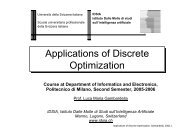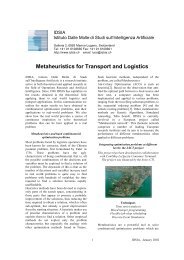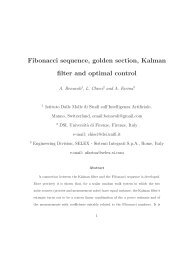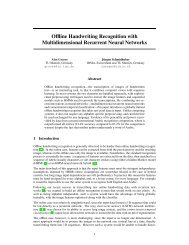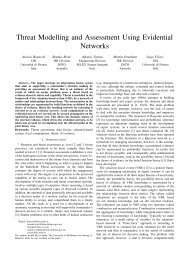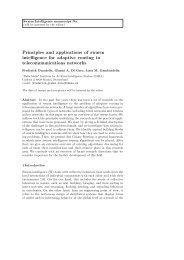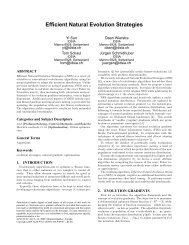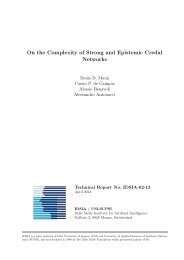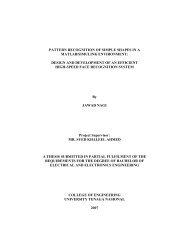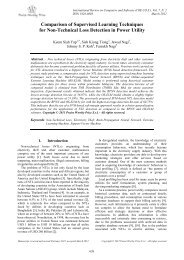AntHocNet: an Ant-Based Hybrid Routing Algorithm for ... - CiteSeerX
AntHocNet: an Ant-Based Hybrid Routing Algorithm for ... - CiteSeerX
AntHocNet: an Ant-Based Hybrid Routing Algorithm for ... - CiteSeerX
You also want an ePaper? Increase the reach of your titles
YUMPU automatically turns print PDFs into web optimized ePapers that Google loves.
In order to guide the <strong>for</strong>ward <strong>an</strong>ts a bit better, we use hello messages 1 :<br />
using these messages, nodes know about their immediate neighbors <strong>an</strong>d have<br />
pheromone in<strong>for</strong>mation about them in their routing table. So when <strong>an</strong> <strong>an</strong>t arrives<br />
in a neighbor of the destination, it c<strong>an</strong> go straight to its goal. Looking<br />
back at the <strong>an</strong>t colony inspiration of our model, this c<strong>an</strong> be seen as pheromone<br />
diffusion: pheromone deposited on the ground diffuses, <strong>an</strong>d c<strong>an</strong> be detected also<br />
by <strong>an</strong>ts further away. In future work we will extend this concept, to give better<br />
guid<strong>an</strong>ce to the exploration by the proactive <strong>an</strong>ts. Hello messages also serve <strong>an</strong>other<br />
purpose: they allow to detect broken links. This allow nodes to cle<strong>an</strong> up<br />
stale pheromone entries from their routing tables.<br />
3.4 Link failures<br />
Nodes c<strong>an</strong> detect link failures (e.g., a neighbor has moved far away) when unicast<br />
tr<strong>an</strong>smissions (of data packets or <strong>an</strong>ts) fail, or when expected hello messages<br />
were not received. When a link fails, a node might loose a path to one or more<br />
destinations. If the node has other next hop alternatives to the same destination,<br />
or if the lost destination was not used regularly by data, this loss is not so<br />
import<strong>an</strong>t, <strong>an</strong>d the node will just update its routing table <strong>an</strong>d send a notification<br />
of the update to its neighbors. On the other h<strong>an</strong>d, if the destination was regularly<br />
used <strong>for</strong> data traffic, <strong>an</strong>d it was the node’s only alternative <strong>for</strong> this destination,<br />
the loss is import<strong>an</strong>t <strong>an</strong>d the node should try to repair the path. This is the<br />
strategy followed in <strong><strong>Ant</strong>HocNet</strong>, with the restriction that a node only repairs<br />
the path if the link loss was discovered with a failed data packet tr<strong>an</strong>smission.<br />
After the link failure, the node broadcasts a route repair <strong>an</strong>t that travels to<br />
the involved destination like a reactive <strong>for</strong>ward <strong>an</strong>t: it follows available routing<br />
in<strong>for</strong>mation when it c<strong>an</strong>, <strong>an</strong>d is broadcasted otherwise. One import<strong>an</strong>t difference<br />
is that it has a maximum number of broadcasts (which we set to 2 in our experiments),<br />
so that its proliferation is limited. The node waits <strong>for</strong> a certain time<br />
(empirically set to 5 times the estimated end-to-end of the lost path), <strong>an</strong>d if no<br />
backward repair <strong>an</strong>t is received, it concludes that it was not possible to find <strong>an</strong><br />
alternative path to the destination which is removed from the routing table.<br />
In the case the node still has other entries <strong>for</strong> the destination(s) involved in a<br />
link failure, but the lost next hop was its best alternative <strong>for</strong> the destination, or<br />
if the link failure was due to <strong>an</strong> <strong>an</strong>t packet, the node will only send a notification<br />
to its neighbors. Also in the case of a failed path repair it will send a similar<br />
notification. The notification contains a list of the destinations it lost a path<br />
to, <strong>an</strong>d the new best estimated end-to-end delay <strong>an</strong>d number of hops to this<br />
destination (if it still has entries <strong>for</strong> the destination). All its neighbors receive<br />
the notification <strong>an</strong>d update their pheromone table using the new estimates. If<br />
1 Hello messages are short messages broadcasted every t hello seconds (e.g., t hello =<br />
1sec) by the nodes. If a node receives a hello message from a new node n, it will add<br />
n as a new destination in its routing table. After that it expects to receive a hello<br />
from n every t hello seconds. After missing a certain number of expected hello’s (2 in<br />
our case), n will be removed.<br />
6



